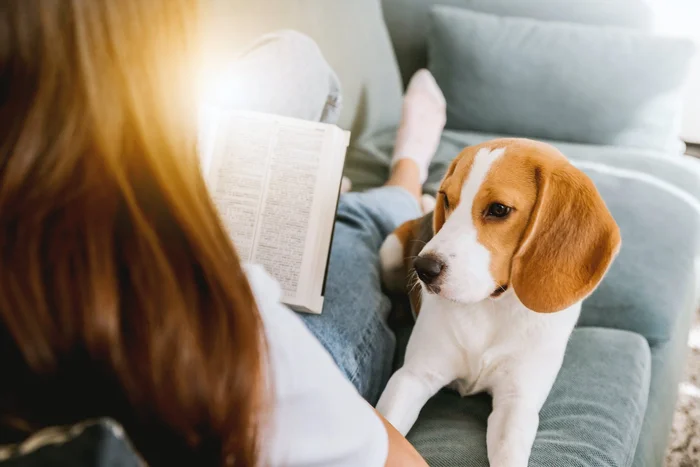popular searches

How To Deal With Separation Anxiety in Pets
written by Ellie Walker
It’s safe to say that as pet parents, we’d love our pets to be with us all the time – and for many pets, the feeling is mutual. Pets that were adopted in the last few years have had the benefit of their pawrent spending more time at home during the workday. Previously, pets would have had to learn to spend long periods alone but this is no longer the case. While this new way of life has many benefits, it has unfortunately caused a rise in the instances of separation anxiety in pets.
What causes separation anxiety in pets?
There’s no one event that causes separation anxiety in pets – each pet’s response to stressors is different. However, there are three common changes that a pet could experience that could trigger the development of separation anxiety.
- Family changes: Pets that have recently been abandoned, surrendered to a shelter, or rehomed can develop separation anxiety.
- Changes in daily schedule: Sudden and drastic changes in daily schedules, such as an increase in the amount of time they spend at home alone, can also trigger separation anxiety in pets.
- Changes in household: Moving to a new house or changes in who lives in the house can cause a pet to feel stressed and, over time, cause separation anxiety.
While these are three common situations that cause separation anxiety in pets, there could be other situations so it’s important that you’re familiar with the signs your pet may display.
Signs of separation anxiety in pets
Just like there’s no one cause of separation anxiety in pets, not every pet shows the same signs. The most common signs of separation anxiety include:
- Destructive behavior: This can include things like chewing or destroying furniture or other household items, especially those close to doors and windows.
- Excessive vocalization: Non-stop howling, barking, and whining that starts within a few minutes of your departure.
- Accidents in the house: Fully housetrained or litterbox trained, but consistently has accidents when home alone.
- Repetitive behaviors: Pacing, licking their paws, biting their tail or other body parts.
- Visible anxiety: Excessive salivation, trembling, panting, or vomiting.
If your pet displays any of these behaviors when left home alone they likely are experiencing separation anxiety, but please note that some of these signs are similar to those of other health issues. This is why it’s important that you schedule an appointment with your veterinarian to rule out any underlying health issues.
How to overcome separation anxiety in pets
Once your pet has been given a clean bill of health, you can look into ways of helping them manage their separation anxiety. For pets that have mild separation anxiety, it can be helpful to try the following methods:
- Start with short periods of alone time: If your pet doesn’t have a lot of experience being home alone, start by leaving them alone for short periods of time – 5 to 10 minutes – and then work your way up. Before you leave, don’t make a big show of saying goodbye to your pet as this will teach them that your leaving is a big deal. Instead, say a quick goodbye and leave calmly.
- Keep their minds active: When a pet’s mind is active, they’re less likely to feel anxious. A Kong filled with their favorite Freshpet recipe or fresh treat will keep them busy for up to an hour, or even longer if you freeze it before giving it to them.
- Give them a special toy: Having a special toy that your pet can only play with while you’re gone is a great way to help them start to associate alone time with something positive. For instance, the Kong filled with Freshpet could be saved as a special treat for when they’re alone – just be sure to put it away as soon as you’re back.
- Leave them in a quiet environment: Some pets can become distressed by sights and sounds from outside when they’re home alone. Closing the blinds and leaving the tv or radio on to muffle noise can be very calming.
- Hire a pet sitter: If you know that you’re going to be out for longer than your pet is comfortable being alone, consider hiring a pet sitter to stay with them. If this is your first time hiring someone to stay with your pet, take a look at our tips for finding a great pet sitter.
- Speak to your veterinarian about medication: If these methods alone are not working, your veterinarian may recommend supplemental medications to help your pet better deal with their separation anxiety.
If your pet’s separation anxiety is not resolved by any of the methods above, you’ll want to speak to a Certified Applied Animal Behaviorist. They will be able to assess the severity of the separation anxiety in your pets, or pet, and develop a plan to help them deal with it. Usually, this involves counter conditioning, which is a process that helps change your pet’s anxious reaction to a relaxed one. This is done by teaching your pet to associate an anxiety-inducing situation, such as being home alone, with something positive, such as their favorite toy or treat. Over time, their feelings of anxiety will be replaced with more positive ones.
We hope that these tips help you deal with separation anxiety in pets. If you have any further questions about separation anxiety, schedule a call with your vet. They’ll be able to answer any of your questions and work with you to come up with a plan to help your pet feel more comfortable being alone.


